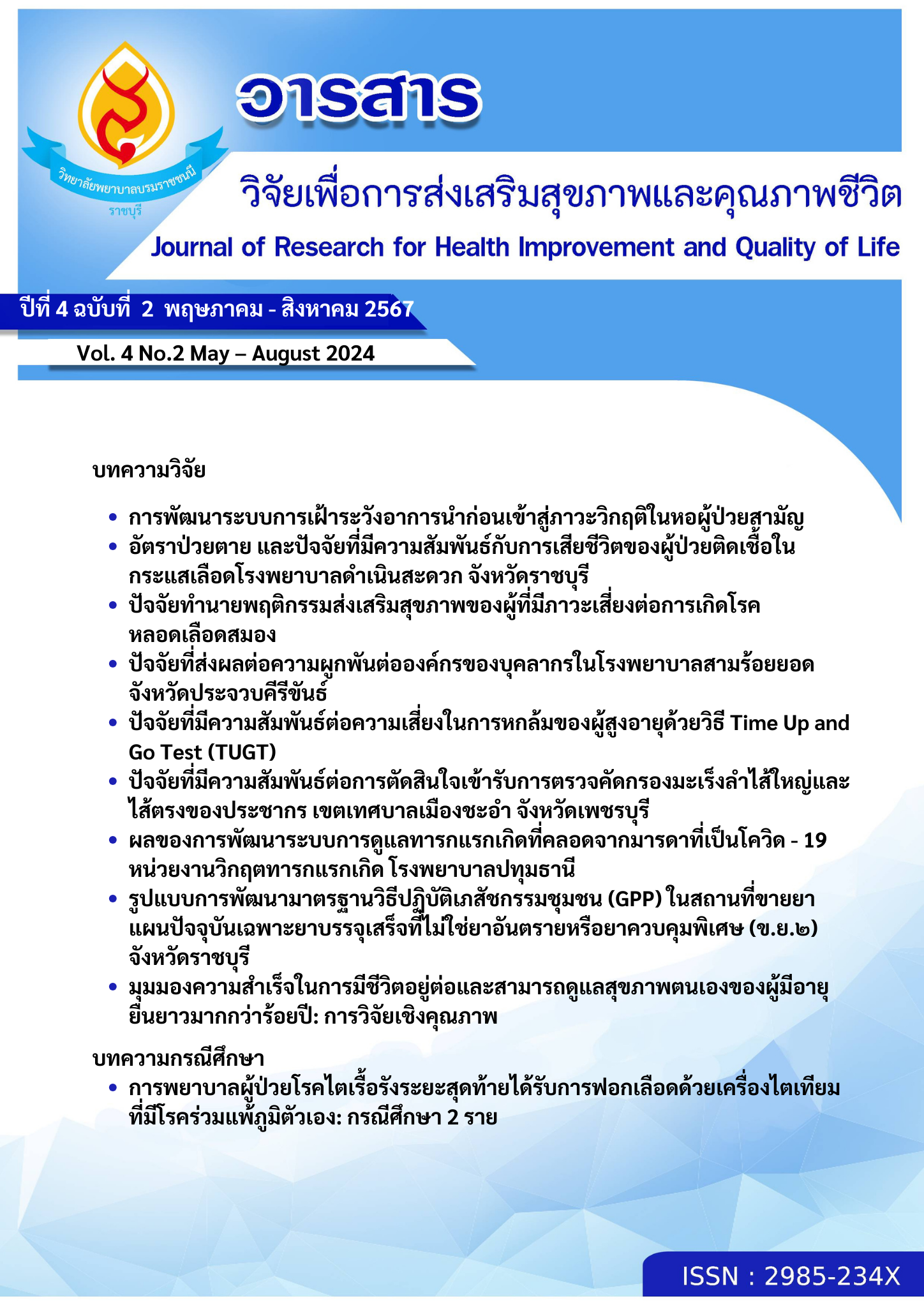อัตราป่วยตาย และปัจจัยที่มีความสัมพันธ์กับการเสียชีวิตของผู้ป่วยติดเชื้อในกระแสเลือดโรงพยาบาลดำเนินสะดวก จังหวัดราชบุรี
คำสำคัญ:
อัตราตาย, ปัจจัยเสี่ยง, ติดเชื้อในกระแสเลือดบทคัดย่อ
การศึกษาเชิงวิเคราะห์ย้อนหลังครั้งนี้มีวัตถุประสงค์เพื่อศึกษาอัตราตาย และปัจจัยที่มีความสัมพันธ์กับการเสียชีวิตของผู้ป่วยติดเชื้อในกระแสเลือดในโรงพยาบาลดำเนินสะดวก จังหวัดราชบุรี กลุ่มตัวอย่าง คือผู้ป่วยในที่วินิจฉัยภาวะติดเชื้อในกระแสเลือดและมีผลเพาะเชื้อในเลือดพบเชื้อก่อโรคในปี 2563 ถึง 2565 จำนวน 319 ราย เครื่องมือวิจัยเป็นแบบบันทึกข้อมูลรายบุคคล ผลทางห้องปฏิบัติการ ความรุนแรง และการรักษา วิเคราะห์ข้อมูลโดยใช้สถิติเชิงพรรณนาและสถิติเชิงอนุมาน วิเคราะห์การถดถอยโลจิสติก นำเสนอค่า Adjusted odds ratio (aOR) ช่วงความเชื่อมั่นที่ร้อยละ 95 และ p-value<0.05
อัตราป่วยตายของผู้ป่วยติดเชื้อในกระแสเลือดเท่ากับ ร้อยละ 29.15 พบปัจจัยที่มีความสัมพันธ์กับการเสียชีวิตเป็นปัจจัยที่เพิ่มโอกาสเสียชีวิต ได้แก่ เพศชาย (aOR: 2.46, 95%CI: 1.334.56) โรคประจำตัวมะเร็ง (aOR: 5.62, 95%CI: 2.45-12.90) การใส่ท่อช่วยหายใจ (aOR: 4.75, 95%CI: 2.22-10.17) ระดับ Serum creatinine (aOR: 1.31, 95%CI: 1.09-1.57) ระดับ Serum lactate (aOR: 1.26, 95%CI: 1.13-1.41) ส่วนปัจจัยที่ลดโอกาสเสียชีวิต ได้แก่ ยาปฏิชีวนะตัวแรกครอบคลุมเชื้อก่อโรค (aOR: 0.42, 95%CI: 0.22-0.77) และระดับ Hemoglobin (aOR: 0.84, 95%CI: 0.76-0.94)
การติดเชื้อในกระแสเลือดยังมีอัตราตายสูง โดยเฉพาะหากพบปัจจัยที่เพิ่มโอกาสเสียชีวิต ควรให้ การรักษาอย่างรวดเร็ว ติดตามผู้ป่วยอย่างเหมาะสม เพื่อลดการเสียชีวิต
เอกสารอ้างอิง
Cardoso, T., Carneiro, A. H., Ribeiro, O., Teixeira-Pinto, A., & Costa-Pereira, A. (2010). Reducing mortality in severe sepsis with the implementation of a core 6-hour bundle: results from the Portuguese community-acquired sepsis study (SACiUCI study). Critical Care, 14(3), 1-11.
Evans, L., Rhodes, A., Alhazzani, W., Antonelli, M., Coopersmith, C. M., French, C., Machado, F. R., Mcintyre, L., Ostermann, M., Prescott, H. C., Schorr, C., Simpson, S., Wiersinga, W. J., Alshamsi, F., Angus, D. C., Arabi, Y., Azevedo, L., Beale, R., Beilman, G., … Levy, M. (2021). Surviving Sepsis Campaign: International Guidelines for Management of Sepsis and Septic Shock 2021. Critical Care Medicine, 49(11), e1063–e1143.
Fleischmann, C., Scherag, A., Adhikari, N. K. J., Hartog, C. S., Tsaganos, T., Schlattmann, P., Angus, D. C., & Reinhart, K. (2016). Assessment of global incidence and mortality of hospital-treated sepsis current estimates and limitations. American Journal of Respiratory and Critical Care Medicine, 193(3), 259–272.
Gu, W.-J., Zhang, Z., & Bakker, J. (2015). Early lactate clearance-guided therapy in patients with sepsis: a meta-analysis with trial sequential analysis of randomized controlled trials. Intensive Care Medicine, 41(10), 1862–1863.
Health Data Center (HDC). (2023). Mortality rate of community-acquired sepsis. [Internet]. https://hdcservice.moph.go.th/hdc/reports/report.php?&cat_id=144fdf97a756b3f82dce197287e06316&id=c335e748195ac0f508168cde7ae50edd
Khwannimit, B., & Bhurayanontachai, R. (2009). The epidemiology of, and risk factors for, mortality from severe sepsis and septic shock in a tertiary-care university hospital setting. Epidemiology and Infection, 137(9), 1333–1341. (in Thai)
Levy, M. M., Evans, L. E., & Rhodes, A. (2018). The Surviving Sepsis Campaign Bundle: 2018 update. Intensive Care Medicine, 44(6), 925–928.
Lindström, A.-C., Eriksson, M., Mårtensson, J., Oldner, A., & Larsson, E. (2021). Nationwide case–control study of risk factors and outcomes for community-acquired sepsis. Scientific Reports, 11(1), 15118.
Machado, F. R., Cavalcanti, A. B., Bozza, F. A., Ferreira, E. M., Angotti Carrara, F. S., Sousa, J. L., Caixeta, N., Salomao, R., Angus, D. C., Pontes Azevedo, L. C., Zajac, S. R., Bley, M. V, Bley, M. V, Scazufca, A., Rosateli, P., Reis, T., Junior, A. N., Neto, P. A. N., Filho, I. L. S., … Lippi, M. M. (2017). The epidemiology of sepsis in Brazilian intensive care units (the Sepsis PREvalence Assessment Database, SPREAD): an observational study. The Lancet Infectious Diseases, 17(11), 1180–1189.
Paudel, R., Bissell, B., Dogra, P., Morris, P. E., & Chaaban, S. (2022). Serum Bicarbonate: Reconsidering the Importance of a Neglected Biomarker in Predicting Clinical Outcomes in Sepsis. Cureus.
Roh, J., Jo, E.-J., Eom, J. S., Mok, J., Kim, M. H., Kim, K. U., Park, H.-K., Lee, M. K., Yeom, S., & Lee, K. (2019). Factors predicting long-term survival of patients with sepsis on arrival at the emergency department. Medicine, 98(33), e16871.
Shankar-Hari, M., Harrison, D. A., Ferrando-Vivas, P., Rubenfeld, G. D., & Rowan, K. (2019). Risk Factors at Index Hospitalization Associated With Longer-term Mortality in Adult Sepsis Survivors. JAMA Network Open, 2(5), e194900.
Singer, M., Deutschman, C. S., Seymour, C., Shankar-Hari, M., Annane, D., Bauer, M., Bellomo, R., Bernard, G. R., Chiche, J. D., Coopersmith, C. M., Hotchkiss, R. S., Levy, M. M., Marshall, J. C., Martin, G. S., Opal, S. M., Rubenfeld, G. D., Poll, T. Der, Vincent, J. L., & Angus, D. C. (2016). The third international consensus definitions for sepsis and septic shock (sepsis-3). In JAMA - Journal of the American Medical Association (Vol. 315, Issue 8, pp. 801–810). American Medical Association.
Wang, M., Jiang, L., Zhu, B., Li, W., Du, B., Kang, Y., Weng, L., Qin, T., Ma, X., Zhu, D., Wang, Y., Zhan, Q., Duan, M., Li, W., Sun, B., Cao, X., Ai, Y., Li, T., Zhu, X., … Xi, X. (2020). The Prevalence, Risk Factors, and Outcomes of Sepsis in Critically Ill Patients in China: A Multicenter Prospective Cohort Study. Frontiers in Medicine, 7, 1-11.
ดาวน์โหลด
เผยแพร่แล้ว
ฉบับ
ประเภทบทความ
สัญญาอนุญาต
ลิขสิทธิ์ (c) 2024 วิทยาลัยพยาบาลบรมราชชนนี ราชบุรี

อนุญาตภายใต้เงื่อนไข Creative Commons Attribution-NonCommercial-NoDerivatives 4.0 International License.
บทความทีตีพิมพ์ในวารสารนี้ถือว่าเป็นลิขสิทธิ์ของวิทยาลัยพยาบาลบรมราชชนนี ราชบุรี และผลงานวิชาการหรือวิจัยของคณะผู้เขียน ไม่ใช่ความคิดเห็นของบรรณาธิการหรือผู้จัดทํา




